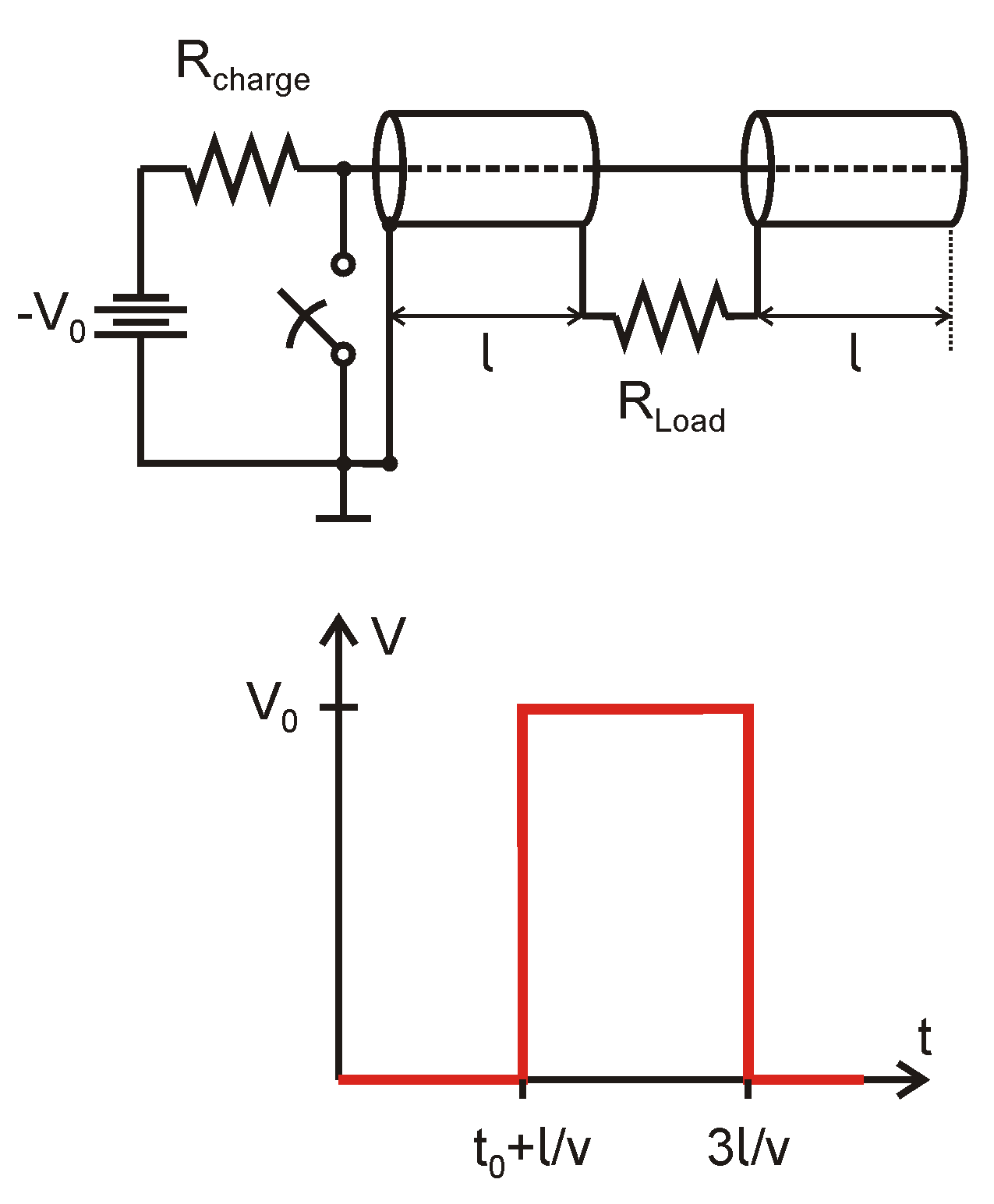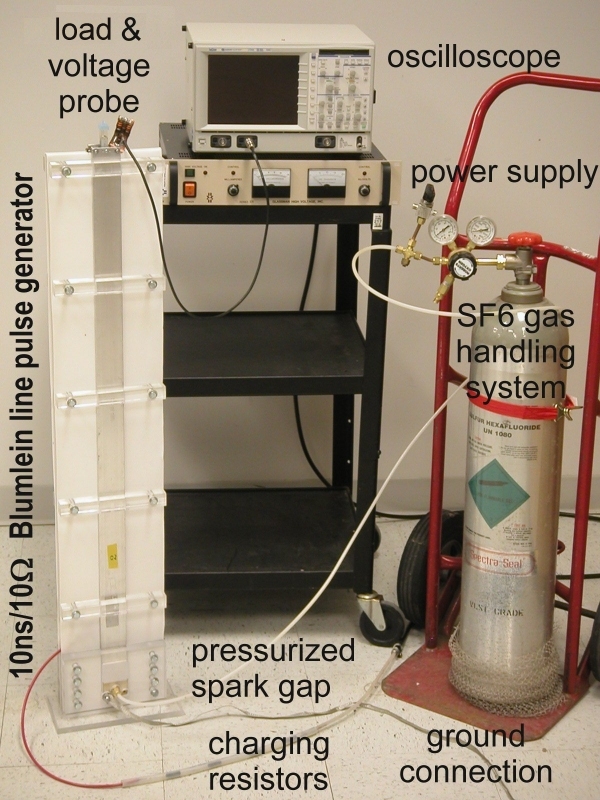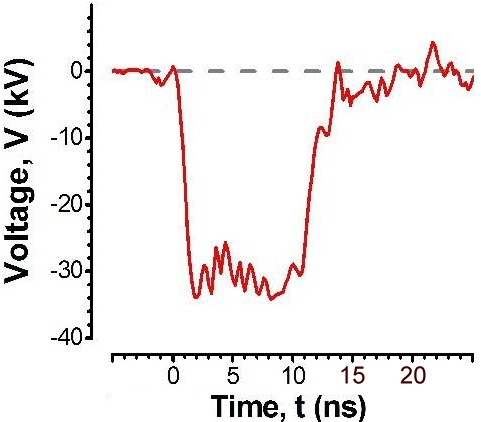Science and Technology of Short Electrical Pulses
 |
||
Concept of a Blumlein line pulse generator. When the switch is closed, an ideally rectancular pulse is applied across a load that has the same impedance as the pulse generator. The amplitude of the of the pulse is determined by the charging voltage and the pulse duration by the length of the transmission lines and the propagation velocity, v, of of the electrical signal. |
As the discipline that has lend its name to this webpage, 'Pulsed Power' is vital or at least contributes significantly to almost every project that we tackle.
(Although not obvious, it is even involved in our research on plasma medicine.) Our focus on Pulsed Power is mainly motivated by our interest in Bioelectrics and lies
in the development of low energy systems, accordingly. However, methods and problems are often the same as seen in larger systems.
Research and applications on the effects of nanosecond pulsed electric fields on cells and tissues requires the delivery of equally short high voltage pulses to the respective target, which is electrically speaking the 'load' of our circuits. The characteristic of this load determines the specifications for the pulse generator. Biological loads typically have low impedance, i.e. they conduct currents rather well. The task of applying a high voltage pulse to such a sample often amounts to the question of how to apply and maintain a certain voltage across a given volume of salt water. (Cells are usually kept in a saline buffer solution and body tissues and fluids have a similarly high conductivity.)
Research and applications on the effects of nanosecond pulsed electric fields on cells and tissues requires the delivery of equally short high voltage pulses to the respective target, which is electrically speaking the 'load' of our circuits. The characteristic of this load determines the specifications for the pulse generator. Biological loads typically have low impedance, i.e. they conduct currents rather well. The task of applying a high voltage pulse to such a sample often amounts to the question of how to apply and maintain a certain voltage across a given volume of salt water. (Cells are usually kept in a saline buffer solution and body tissues and fluids have a similarly high conductivity.)
 |
||
 |
||
Blumlein line pulse generator for the generation of a 10-ns pulse with an amplitude of 35 kV into a 10-Ω load. Instead of cables, the transmission line was build as stripline. A pressurized spark gap provides a rise time of only 1 ns. |
In addition to being delivered to a specific load, high voltage pulses mostly need to be delivered in a certain "shape", which depends on the particular objective of
an application. To achieve a homogenous exposure, our research on the effects of nanosecond pulsed electric fields, is done with well defined rectangular high voltage
pulses, i.e. maintaining a given voltage across the load for a specified period of time. Other applications, such as the generation of streamers for example, require
the fast multiplication of a better manageable lower input voltage instead. How a pulse can be delivered from the pulse generator to the load without significant
losses and pulse distortions is another common problem of Pulsed Power Engineering.
Along with the requirements on pulse shaping and delivery for specific applications come various challenges on materials, high voltage insulation design, storage of electrical energy, fast switching of high voltages, diagnostic of pulsed voltages and currents etc. (Many of these topics are covered in my class on Pulsed Power and hopefully eventually on the accompanying web-pages here. This also serves me as an excuse, allowing me treating this wide and multi-facetted topic on this site here rather superficial.)
Our most popular design for the generation of rectangular high voltage pulses is based on an intriguingly simple concept developed by Alan Blumlein (1903-1942), the so-called Blumlein line, which utilizes the propagation of electric signals along a transmission line. The transmission line itself can be build to 'match' the impedance of the load, i.e. load impedance and pulse generator impedance are the same. After the transmission line is charged with a high voltage, a fast switch starts the propagation of signals in the lines, which superimpose to a rectangular pulse across the load. The pulse duration is determined by the lenght of the transmission lines and the propagation velocity of the elctrical signals in these lines. The leading edge of the pulse, the rise time is mostly determined by the closing time of the switch, i.e. how fast it can turn from the ideally insulating into the ideal conducting state. Since this has to be accomplished for voltages of at least several tens of kilovolts in times on the order of only a few nanoseconds, many of the efforts in pulsed power are devoted to switching. (Another very simple, nevertheless successful concept in this respect is the spark gap switch that is used as logo in the upper left corner of this website.)
Along with the requirements on pulse shaping and delivery for specific applications come various challenges on materials, high voltage insulation design, storage of electrical energy, fast switching of high voltages, diagnostic of pulsed voltages and currents etc. (Many of these topics are covered in my class on Pulsed Power and hopefully eventually on the accompanying web-pages here. This also serves me as an excuse, allowing me treating this wide and multi-facetted topic on this site here rather superficial.)
Our most popular design for the generation of rectangular high voltage pulses is based on an intriguingly simple concept developed by Alan Blumlein (1903-1942), the so-called Blumlein line, which utilizes the propagation of electric signals along a transmission line. The transmission line itself can be build to 'match' the impedance of the load, i.e. load impedance and pulse generator impedance are the same. After the transmission line is charged with a high voltage, a fast switch starts the propagation of signals in the lines, which superimpose to a rectangular pulse across the load. The pulse duration is determined by the lenght of the transmission lines and the propagation velocity of the elctrical signals in these lines. The leading edge of the pulse, the rise time is mostly determined by the closing time of the switch, i.e. how fast it can turn from the ideally insulating into the ideal conducting state. Since this has to be accomplished for voltages of at least several tens of kilovolts in times on the order of only a few nanoseconds, many of the efforts in pulsed power are devoted to switching. (Another very simple, nevertheless successful concept in this respect is the spark gap switch that is used as logo in the upper left corner of this website.)
The design of Blumlein line pulse generators for exposures of cell suspensions in cuvettes, single cells under the microscope or solid tumors is only one of many developments that we pursue. Other efforts are the development of drivers for near-field radiation sources, Marx banks for water purification systems, the investigation of new switching and energy storage systems and many others. A related topic is also the evaluation of the bulk exposure parameters of the respective applications. This can be as simple as the analysis of the electric field that is applied or as complicated as the shockwave that is driven by a spark that is instigated by a given pulse shape.
For more details or information check out our publications or send me an email.